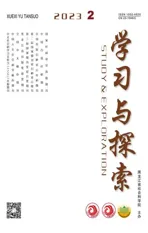ABSTRACTS
2023-04-16
AnAnalysisofthePoliticalDevelopmentPatternofWhole-processPeople’sDemocracyfromaComparativePerspective
LI Xiao-yu
(ScientificSocialismTeachingandResearchDepartment,PartySchooloftheCentralCommitteeC.P.C/NationalAcademyofGovernance,Beijing100089,China)
Abstract:Democracy is the main goal of modern political development. The Western paradigm of democratic transformation has analyzed and guided the goal, power and paths of many late-developing countries’ democracy development. However, this paradigm suffers from the drawbacks of considering competitive elections as the only goal of political development, denying economic and social development as the structural prerequisite of democratic politics. Since the reform and opening up, China has developed a distinctive path of socialism with Chinese characteristics. The whole-process people’s democracy is the latest form of socialist democratic politics with Chinese characteristics in the new era. The political development pattern from people’s democracy to the whole-process people’s democracy can be summarized as: the ruling party and its dominant public authority act as the pivotal force in state building and democratic development, set the development goals based on China’s reality, self-improve and develop the socialist political system, and gradually promote the reform of the political system, promote democratic innovation according to the needs of economic and social development, and achieve the organic unity of reform, development and stability. The path of political development of socialism with Chinese characteristics has provided positive and effective reference and inspiration for late-developing countries in constructing democracy.
Keywords:the Whole-process People’s Democracy; a Chinese Path to Modernization; Democratic Transition; Political Development Pattern
AnAnalysisofEconomicPolicyUncertainty,NationalSavingsRateandItsHeterogeneity
WANG Dong1, WANG Zi-wei1, CHEN Ming-sheng2
(1.SchoolofPublicAdministration,NanjingUniversityofFinance&Economics,Nanjing210023,China; 2.SchoolofHealthPolicy&Management,NanjingMedicalUniversity,Nanjing211166,China)
Abstract:As a representative of emerging economies, China’s savings rate ranks among the highest in the world. Based on the dynamic panel data of 16 major economies in the world from 1998 to 2019, this paper uses the uncertainty index of economic policy calculated by Baker.S and other scholars as the core explanatory variable, and constructs a two-way fixed effect model and a systematic GMM model on the basis of controlling variables such as child dependency ratio, so as to analyze the impact of economic policy uncertainty on the national savings rate. Empirical studies have found that there is a significant positive relationship between economic policy uncertainty and national savings rate, and there are obvious heterogeneity characteristics in countries with different income levels. At present, under the background of the deep adjustment of the world economy, how to rationalize the design of domestic macroeconomic policies, smooth out the economic fluctuations caused by international trade disputes and the impact of the COVID-19, guide domestic residents to rationally allocate savings and consumption from the demand side, and promote the orderly growth of the domestic economy has become a realistic problem that countries urgently need to solve.
Keywords:Economic Policy; Uncertainty; Savings Rate; Heterogeneity
